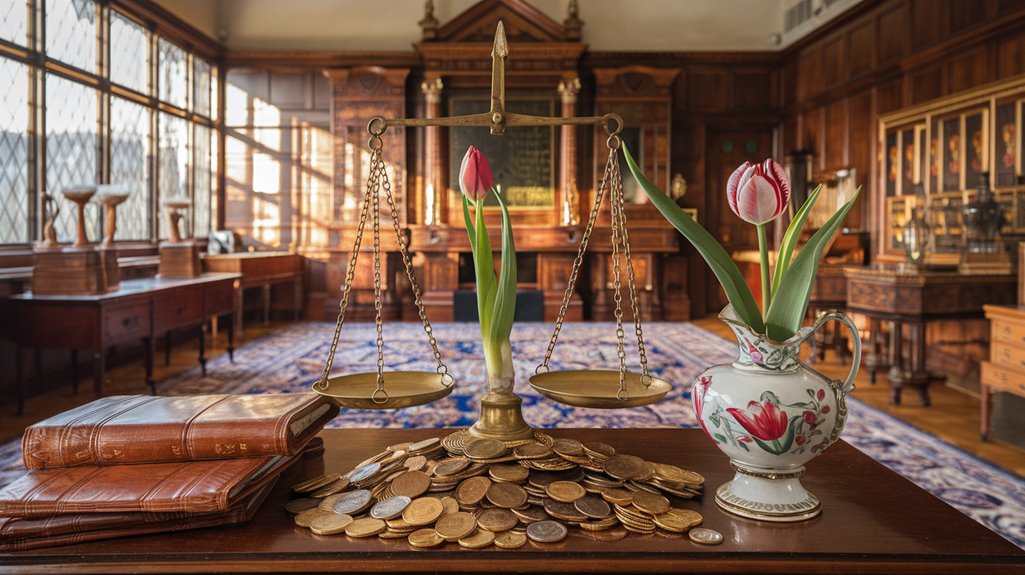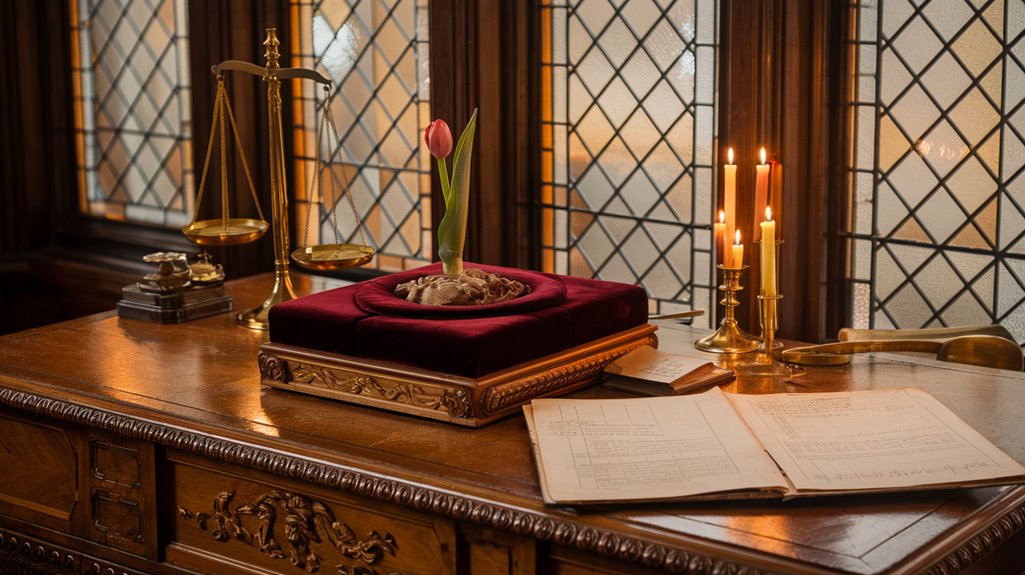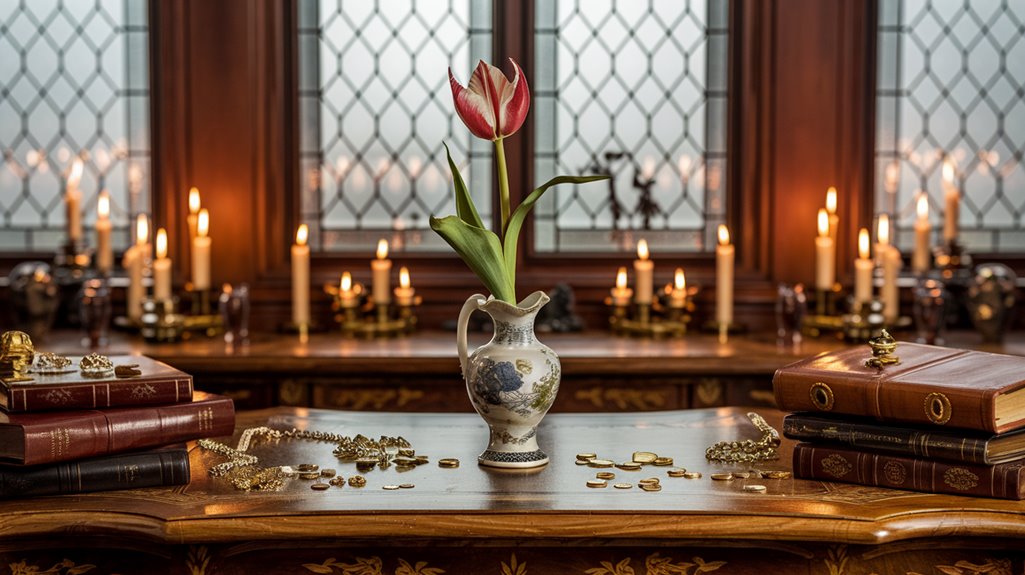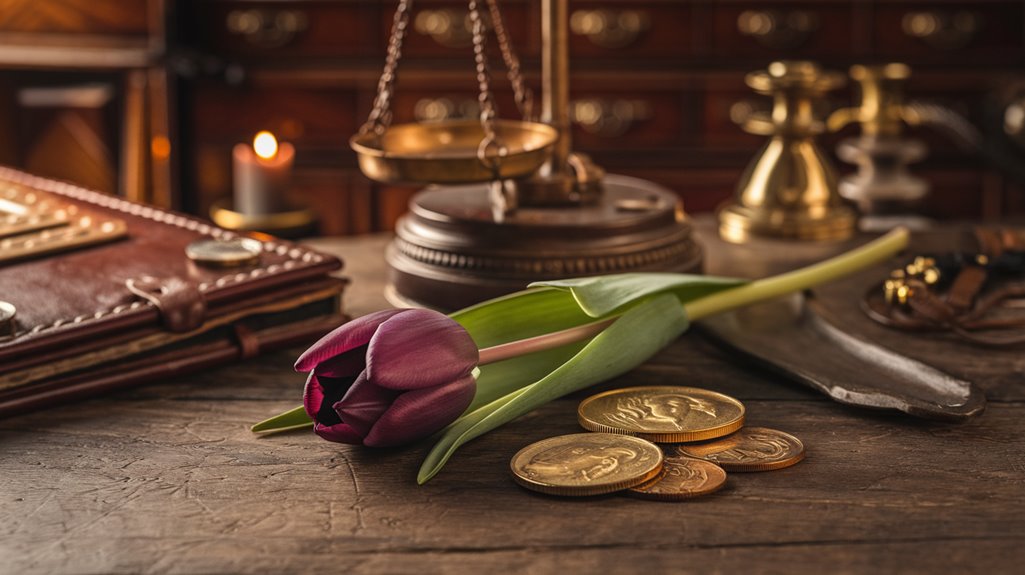Tulips Were Once More Expensive Than Gold
Imagine you're a wealthy Dutch merchant in 1637, contemplating whether to trade your three-story canal house for a single Semper Augustus tulip bulb. You're not alone in this seemingly absurd decision – during the height of tulip mania, these flowers became more precious than gold itself. While today's investors chase cryptocurrencies and tech stocks, the tulip bubble remains history's first documented market frenzy, and its lessons still echo through modern economics.
The Rise of Dutch Tulip Trading

When tulips first arrived in Europe from the Ottoman Empire in the 16th century, no one could have predicted their meteoric rise in value. The Dutch tulip trade truly took off in 1593 when Carolus Clusius began tulip cultivation at the University of Leiden, setting the stage for an unprecedented market phenomenon.
You'd be amazed to learn that these flowers became so valuable that a single rare bulb could cost as much as a mansion on Amsterdam's Grand Canal. The most desirable tulips were those affected by the tulip breaking virus, which created vibrant, multicolored patterns on the petals.
The trade flourished in taverns across Dutch towns, where traders used notaries and paid a 2.5% "wine money" fee to validate their contracts. As demand outpaced supply, market speculation intensified, with forward contracts allowing you to purchase bulbs at the end of the season. The most expensive variety, known as the Semper Augustus, commanded prices of up to 5,200 florins.
Skilled artisans would've needed ten years' worth of income to afford the rarest varieties.
How Tulip Bulbs Became a Status Symbol
The tulip's path to becoming Europe's most coveted status symbol began in the Ottoman Empire's lavish gardens. You'd find these prized flowers adorning the textiles, carpets, and buildings of wealthy sultans, who celebrated their beauty in grand festivals.
The essence of this tulip symbolism traveled to Europe when an ambassador gifted bulbs to Carolus Clusius in Vienna. Silk Road traders first brought these exotic blooms westward from the Asian highlands. The event ignited one of the world's first speculative market bubbles in history.
Once planted in the Netherlands' Leiden University garden, tulips transformed into the ultimate luxury items. You could spot them in prestigious still-life paintings, intricate Delftware pottery, and embroidered textiles.
The most valuable were rare varieties with unique patterns caused by the tulip breaking virus. These flowers became so prestigious that a single bulb could cost as much as a house, leading wealthy Europeans to showcase them in formal gardens and elaborate floral arrangements.
The Peak of Tulip Mania: Staggering Price Records
Tulip mania reached dizzying heights in 1637, when a single Semper Augustus bulb commanded 5,200 guilders—enough to buy a luxurious Amsterdam canal house.
You'd have needed three years of a merchant's salary to afford just one bulb. The extreme price volatility meant fortunes were made and lost weekly, with some varieties like Witte Croonen surging 26 times in value before crashing spectacularly.
Bulb rarity drove the market to unprecedented levels, particularly for striped varieties. The craze began after Turkish ambassadors shared precious tulip seeds with European botanists.
You could've traded a brewery or several hectares of land for just one precious bulb.
- Semper Augustus became the most expensive tulip in history
- Some bulbs were worth more than their weight in gold
- A single bulb could serve as a wedding dowry
- Buyers often purchased bulbs using credit
- "Broken" tulips commanded the highest prices due to slow propagation
When the Tulip Market Crashed
All market bubbles must burst, and in February 1637, what went up came crashing down.
You would've witnessed tulip prices halving within days as panic selling swept through the Dutch markets. The complex market dynamics of supply and demand had finally reached their breaking point. At their peak, some rare tulip bulbs were worth six times yearly wages.
The crash exposed how speculative behavior and credit-based purchases had inflated prices far beyond tulips' intrinsic value.
When buyers couldn't fulfill their futures contracts, defaults spread like wildfire. The Amsterdam government had to step in, nullifying many contracts to prevent widespread financial ruin.
While bankruptcies doubled between 1635 and 1637, the impact remained largely contained to tulip growers and speculators.
Lessons From History's First Economic Bubble

Looking back at history's first recorded economic bubble, we can extract valuable insights that remain relevant today. The tulip mania demonstrates how unchecked speculative behavior can destabilize economic stability and lead to devastating financial consequences. The Semper Augustus tulip became the most coveted and expensive variety, symbolizing the market's peak extravagance. During the height of trading, skilled craftsmen's wages were dwarfed by tulip prices that reached ten times their annual income.
You'll find that many modern market crashes mirror the same patterns seen in 17th-century Netherlands.
- Excessive money supply and inflation can create dangerous market conditions
- Speculation driven by greed rather than intrinsic value leads to unsustainable prices
- Financial innovations (like bank money) can have unintended consequences
- Elite propaganda can influence market behavior and fuel bubbles
- Markets eventually correct themselves, often with severe repercussions
The tulip bubble serves as a timeless reminder that when investors prioritize quick profits over fundamental value, the resulting crash can wipe out fortunes overnight and impact entire economies.






